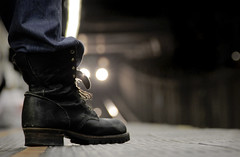JFK Security Guards Pause Strike for Talks with AirServ

Security guards at New York’s John F. Kennedy International Airport have paused their strike now that the Port Authority has asked their employer to meet with them.
The guards at JFK will have lots to talk about with AirServ, starting with the fact that they, the professionals who keep terrorists from skirting TSA checkpoints, earn poverty wages and don’t get sick days:
[Prince Jackson, a guard at JFK’s Delta Terminal] wasn’t thrilled about the wages—less than he’d made in other security jobs—but Jackson was desperate. He has been working the overnight shift ever since—except for a week last year when he got a severe stomach flu.
Jackson found a clinic in Astoria that would treat him for $15. “When I came back the next week, I brought a doctor’s note, so they didn’t fire me. But we don’t get sick days, so I didn’t get paid. That really put me in the hole. I’m still behind on my rent.”
On its website, Air Serv describes itself as a people company. “To have satisfied customers, you must first have employees who feel valued and are recognized for exceptional job performance… . Once a year, 110% Club galas are held across the country to recognize those employees who play a huge role in our success.”
Jackson isn’t convinced. “We never heard anything about a 110 Club,” he says. “The first time they mentioned that was when we started talking about a union.” [Village Voice]
The guards are working with SEIU 32BJ, which specializes in organizing security workers and other support staff. Even if the talks go well, the AirServ guards are still expecting a long fight for fair pay and decent working conditions.
[Photo credit: Prince Jackson, JFK guard, by Dania Eliazov.]








